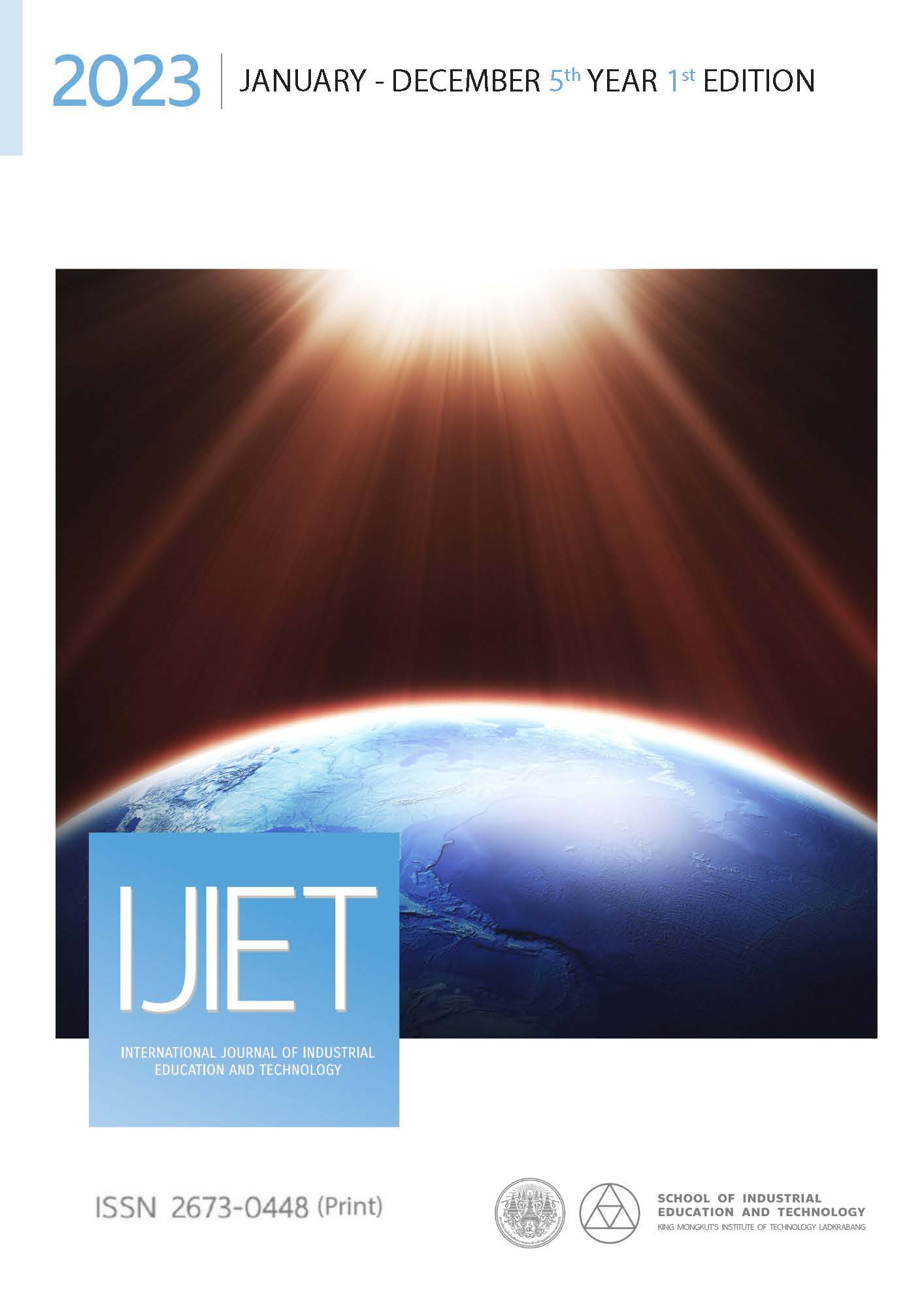SKY PLOT VISIBILITY BASED ON BEIDOU AND GPS SATELLITES OVER BANGKOK, THAILAND
Keywords:
Sky visibility, BeiDou satellite, GPS satellite, Sky plot, GNSSAbstract
The Global Navigation Satellite System (GNSS) over the Bangkok region occasionally has spots where its performance could be more consistent and imprecise due to the dust in the sky, the surroundings, and high buildings. As a reason, the area has an impact on satellite signal reception. As a reason, the area has an impact on satellite signal reception. As a reason, the area has an impact on satellite signal reception. It blocks and reflects satellite signals and more than the visibility of GNSS satellites is needed to be useful. We offer a sky visibility analysis based on satellites classification. We provide information on sky visibility estimation for BeiDou and GPS satellites based on direct GNSS receiver measurements.The visibility of BeiDou and GPS satellites is classified by sky plotting techniques. For our proposed analytical evaluation of the visibility satellites over Bangkok on November 8th, 2023, we found that the locations of BeiDou and GPS satellites were at different times and affected the efficiency of analyzing the visibility of sky plots throughout Bangkok, Thailand.
References
An, X., Meng, X., & Jiang, W. (2020). Multi-constellation GNSS precise point positioning with multi-frequency raw observations and dual-frequency observations of ionospheric-free linear combination. Satellite Navigation, 1(1), 1-13. doi:10.1186/s43020-020-0009-x.
Cai, C., Gao, Y., Pan, L., & Zhu, J. (2015). Precise point positioning with quad-constellations: GPS, BeiDou, GLONASS and Galileo. Advances in Space Research, 56(1), 133-143. doi:10.1016/j.asr.2015.04.001.
Colagrossi, A., Prinetto, J., Silvestrini, S., & Lavagna, M. (2020). Sky visibility analysis for astrophysical data return maximization in HERMES constellation. Journal of Astronomical Telescopes, Instruments, and Systems, 6(4), 1-30. doi:10.1117/1.JATIS.6.4.048001.
Dabove, P., & Pietra, V. D. (2019). Single-baseline RTK positioning using dual-frequency GNSS receivers inside smartphones. Sensors, 19(19), 1-17. doi:10.3390/s19194302.
Ding, M., Chen, W., & Ding, W. (2023). Performance analysis of a normal GNSS receiver model under different types of jamming signals. Measurement, 214, 1-13. doi:10.1016/j.measurement.2023.112786.
Garcez, C. C., de Lima, D. V., Miranda, R. K., Mendonça, F., da Costa, J. P. C., de Almeida, A. L., & de Sousa, R. T. Jr. (2019). Tensor-based subspace tracking for time-delay estimation in GNSS multi-antenna receivers. Sensors, 19(23), 1-15. doi:10.3390/s19235076.
Geng, J., Guo, J., Chang, H., & Li, X. (2019). Toward global instantaneous decimeter-level positioning using tightly coupled multi-constellation and multi-frequency GNSS. Journal of Geodesy, 93, 977-991. doi:10.1007/s00190-018-1219-y.
Hamza, V., Stopar, B., & Sterle, O. (2021). Testing the performance of multi-frequency low-cost GNSS receivers and antennas. Sensors, 21(6), 1-16. doi:10.3390/s21062029.
Hamza, V., Stopar, B., Ambrožič, T., Turk, G., & Sterle, O. (2020). Testing multi-frequency low-cost GNSS receivers for geodetic monitoring purposes. Sensors, 20(16), 1-16. doi:10.3390/s20164375.
Hamza, V., Stopar, B., Sterle, O., & Pavlovčič-Prešeren, P. (2023). Low-cost dual-frequency GNSS receivers and antennas for surveying in urban areas. Sensors, 23(5), 1-19. doi:10.3390/s23052861.
Huang, K. Y., Juang, J. C., Tsai, Y. F., & Lin, C. T. (2021). Efficient FPGA implementation of a dual-frequency GNSS receiver with robust inter-frequency aiding. Sensors, 21(14), 1-20. doi:10.3390/s21144634.
Jia, X., Cheng, G., Ji, Y., Sun, X., & Wu, J. (2022). GNSS single-frequency, single-epoch attitude determination method with orthogonal constraints. Mathematical Problems in Engineering, 2022, 1-9. doi:10.1155/2022/4426987.
Kenpankho, P., Chaichana, A., Trachu, K., Supnithi, P., & Hozumi, K. (2021). Real-time GPS receiver bias estimation. Advances in Space Research, 68(5), 2152-2159. doi:10.1016/j.asr.2021.01.032.
Li, X., Guo, B., Lu, C., Ge, M., Wickert, J., & Schuh, H. (2014). Real-time GNSS seismology using a single receiver. Geophysical Journal International, 198(1), 72-89. doi:10.1093/gji/ggu113.
Liu, T., Chen, H., Chen, Q., Jiang, W., Laurichesse, D., An, X., & Geng, T. (2021). Characteristics of phase bias from CNES and its application in multi-frequency and multi-GNSS precise point positioning with ambiguity resolution. GPS Solutions, 25(58), 1-13. doi:10.1007/s10291-021-01100-7.
Lu, Y.-H., & Han, J.-Y. (2020). GNSS satellite visibility analysis based on 3D spatial information in urban areas. The International Archives of the Photogrammetry, Remote Sensing and Spatial Information Sciences, 43, 123-128. doi:10.5194/isprs-archives-XLIII-B4-2020-123-2020.
Mao, J., Wang, Q., Liang, Y., & Cui, T. (2021). A new simplified zenith tropospheric delay model for real-time GNSS applications. GPS Solutions, 25(43), 1-12. doi:10.1007/s10291-021-01092-4.
Odolinski, R., & Teunissen, P. J. (2020). Best integer equivariant estimation: Performance analysis using real data collected by low-cost, single-and dual-frequency, multi-GNSS receivers for short-to long-baseline RTK positioning. Journal of Geodesy, 94(9), 1-17. doi:10.1007/s00190-020-01423-2.
Tu, R., Zhang, P., Zhang, R., Fan, L., Han, J., Hong, J., Liu, J. & Lu, X. (2021). Precise frequency transfer model suitable for short baseline link based on GPS single-differenced observations with ambiguity resolution. Acta Geodaetica et Geophysica, 56, 345-355. doi:10.1007/s40328-021-00332-w.
Wielgocka, N., Hadas, T., Kaczmarek, A., & Marut, G. (2021). Feasibility of using low-cost dual-frequency GNSS receivers for land surveying. Sensors, 21(6), 1-14. doi:10.3390/s21061956.
Xu, H., Hsu, L. T., Lu, D., & Cai, B. (2020). Sky visibility estimation based on GNSS satellite visibility: An approach of GNSS-based context awareness. GPS Solutions, 24(59), 1-15. doi:10.1007/s10291-020-0973-5.
Yang, C. K., & Shim, D. S. (2013). Analysis of the effect of time delay on the integrated GNSS/INS navigation systems. TransNav: International Journal on Marine Navigation and Safety of Sea Transportation, 7(2), 199-204. doi:10.12716/1001.07.02.06.
Zhang, B., Hou, P., Liu, T., & Yuan, Y. (2020). A single-receiver geometry-free approach to stochastic modeling of multi-frequency GNSS observables. Journal of Geodesy, 94(37), 1-21. doi;10.1007/s00190-020-01366-8.
Downloads
Published
Issue
Section
License
Copyright (c) 2023 International Journal of Industrial Education and Technology

This work is licensed under a Creative Commons Attribution-NonCommercial-NoDerivatives 4.0 International License.



